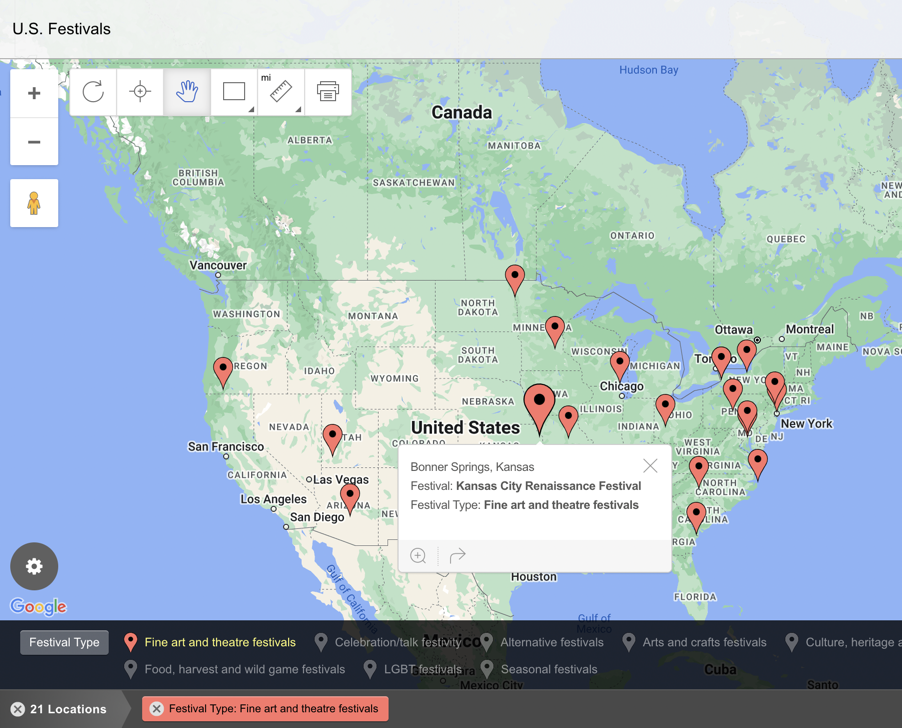U.S. Festival Types on a Map
We love our obscure celebrations in the United States. Often, these are local events of much note, and we’ve gathered a bunch of them for you on a map.
Yet the 182 festivals that take place each year across the U.S. aren’t very easily defined. Not to stop us from trying to put them into categories or types. These range from arts and crafts festivals to transportation festivals. The two most common festival types include 64 individual events across the country—and there are some pretty spectacular individual events within each type (Sawdust Art Festival, anyone?), as you’ll see on the map below.
View U.S. Festivals in a full screen map
The Two Most Common Festival Types
By far, the two most popular kinds are 1. food, harvest, and wild game and 2. culture, heritage, and folk festivals. While certainly not exhaustive, Wikipedia reports that 32 celebrations in the U.S. fall into each of these two categories, so let’s take a look at some individual examples of these festival types.
Food, Harvest, and Wild Game Festivals
The food, harvest, and wild game festival type is pretty self-explanatory. Six such events occur each year in Ohio:
- Banana Split Festival (Wilmington, Ohio)
- Pumpkin Festival (Barnesville)
- Pumpkin Show (Circleville)
- Festival of the Fish (Vermilion)
- County Apple Festival (Jackson)
- Sweet Corn Festival (Fairborn)
Ohio certainly loves its pumpkins—though it’s not the only state with pumpkin-themed events. California’s Half Moon Bay hosts a Half Moon Bay Art and Pumpkin Festival, along with two more events that fall into the food, harvest, and wild game festival category. The Morton Pumpkin Festival also happens each year in Illinois, in addition to another festival of this type. As for where the largest pumpkins of all time are grown, check out our post on the topic.
On the same note, five food, harvest, and wild game festivals take place in North Carolina while two are held in Louisiana, Texas, and New York, including two in the same city: the National Buffalo Wing Festival and Taste of Buffalo, which we assume involves either multiple cuisines prominent in the city or the animal.
Interactive Maps Made Easy
Sign Up NowFestivals of Culture, Heritage, and Folk
As for the other most common type of festival, Texas is home to the most culture, heritage, and folk festivals (four). Borderfest is the largest and oldest music festival in South Texas, held each year in the Rio Grande Valley.
Meanwhile, Dallas hosts two festivals of this type: a Greek Food Festival and the North Texas Irish Festival. Dallas’s Irish Festival may be the second oldest Irish festival in the country, but it’s far from the only one held in the U.S. There’s also the Riverfront Irish Festival in Cuyahoga Falls, Ohio and the Dublin Irish Festival—also in the Buckeye State. Plus, the capital of Indiana throws an Indy Irish Festival while the Kansas City Irish Fest takes place in Kansas City, Missouri.
Last for Texas is the Texas Folklife Festival, which comes around each year in San Antonio.
To see Ohio’s third festival that doesn’t fall into this category, click through the map. Otherwise, we’re moving on to the rest of the festival types.
How to Analyze the Other 19 U.S. Festival Types
You know about the two most common festival types in the U.S. But with 182 total festivals, food, harvest, and wild game festivals and culture, heritage, and folk festivals certainly aren’t the only types.
| Festival type | No. of festivals |
|---|---|
| Food, harvest and wild game festivals | 32 |
| Culture, heritage and folk festivals | 32 |
| Fine art and theatre festivals | 21 |
| Arts and crafts festivals | 17 |
| Flower festivals | 11 |
| Celebration/talk festivity | 10 |
| Alternative festivals | 10 |
| LGBT festivals | 9 |
| Seasonal festivals | 7 |
| Contemporary Christian Festivals | 5 |
| Holiday festivals | 4 |
| Storytelling festivals | 3 |
| Rodeo and horse racing festivals | 3 |
| Religious festivals | 3 |
| Pioneer festivals | 3 |
| Pagan festivals | 3 |
| Beer festivals | 3 |
| Sports festivals | 2 |
| Science festivals | 2 |
| Transportation festivals | 1 |
| Innovation festivals | 1 |
Tables like the one above are great for displaying your data. But when you want to analyze the same information, there are far better tools, including those that map your data.
Many mapping software options enable you to plot your points, such as ArcGIS and other desktop GIS software, Google Maps API, and web-based mapping tools.

But fewer offer the ability to group your data. When you map your data, you typically have more information than just location. This is why BatchGeo enables you and other users of your map to select only the markers that meet certain requirements, filtering out the rest. Groups can be combined to zero in on very specific results, giving you insight into the story behind the map.
Get started for free at batchgeo.com.
